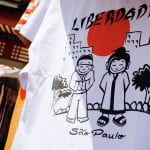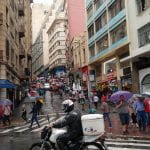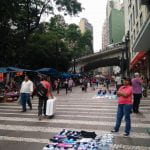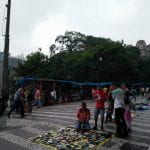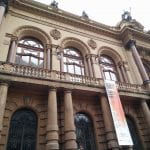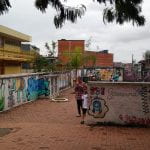São Paulo, a city of color
São Paulo vibrates with colors. From graffiti-filled walls to green-filled sky. From glassy modern skyscrapers to charming old-age downtown. From intricately crafted trinkets to shiny boutiques. Colors weave together to tell stories of individual voices and social landscape, of human talent and nature power, of unrelenting urban contestation and transformation. Colors mark a São Paulo unique in its struggles and triumph of a young democracy and an emerging economy.
Art
Graffiti*and pixação** set São Paulo apart. According to one of the artists in our panel on graffiti and tagging, São Paulo is the most painted city in the world. On our first day in the city, we were all taken aback by the prevalence of drawings on building walls and bridge pillars. Every step would bring a new thought-provoking image into sight, from female faces, natural scenery to abstract creation. Later on into the second week of our program, through readings, class discussion, site visits and guest lectures we learned that behind those images lies a more sophisticated reality of social marginalization and youth resistance. Graffiti and pixação artists usually come from poor, crime-ridden, non-central areas where lack of public space for cultural and community development is the norm. By leaving their marks on the city’s infrastructure, these young voices are acknowledging their presence and expressing their dissatisfaction in an urban space that fails to democratically represent their interests. “We are just protecting our rights and our voices”, a guest graffiti artist emphasized to us. Graffiti and pixação are speaking out loud the language of change and justice in São Paulo.
(*) Although it is hard to tell the difference between street art and graffiti, a graffiti artist we had the chance to talk with in class emphasized that graffiti is not just art, but a “political movement”. According to his life-long involvement in graffiti, this movement is like “an underground mafia group” with specific rules and structures in drawings only people in the movement know, and that one needs to be introduced or recommended through personal connection to join the movement.
(*) pixação is translated into “tagging” in English, usually spotted on walls of high apartment buildings. Started in 1980s, São Paulo’s pixação developed into a unique form of thin, pointy letters that are usually fathomable only its creators.

Seen at Street art corner in Vila Madalena

Seen in Perdizes

“If it’s not illegal, it’s not graffiti” – Tinho, a graffiti artist in our panel. Tinho drew the mural above.

Seen at Tiradentes station

Our site visit team (with Tinho the third person from the left)

pixação

pixação in Old City Center
Markets
Outdoor markets serve as a particular attraction of São Paulo. On weekends at specific places in the city, local business and artisans from every corner of São Paulo state, or even Brazil, gather to showcase their handmade products. There are also street markets throughout the week that represent a blend of formal and informal commercial activities in Brazil.
Seen at Sunday Market in Liberdade neighborhood.
Views from Rua 25 de Marco (March 25th street market) – largest wholesale market in Latin America
Buildings
“Buildings are material expression of historical processes” – Juan Arbona, traveling faculty member in our program
As São Paulo becomes more and more crowded under waves of both domestic and international migration, high residential and working buildings have rapidly risen up.

A suburban living space
Buildings in Old City Center
Images taken from our site visit at Heliopolis, which is known as the second largest favela (translated as “slum”) in Brazil. Heliopolis is one-hour away from the city center – we had to switch 2 buses to get there. The neighborhood reflected a history of low-income families being pushed to the periphery and deprived of access to facilities in urban center. I came to Heliopolis expecting to see a slum-like living condition similar to what I was exposed to in India. However, the whole visit took me from one pleasant surprise to another to see how far Heliopolis has transformed in improving the living conditions of its residents. I was impressed to know that the people in the neighborhood, with most males being construction workers, managed to re-build their houses on their own. Significant NGO and communal efforts have gone into constructing public facilities and educational spaces (public library, schools, a park etc.). Local shops and commercial centers were also established to reduce residents’ reliance on the city center. Although Heliopolis, as a favela, is still faced with issues of crime, drugs and violence,the neighborhood is growing into a “self-sustaining city”, as described by our site visit guide, to cater for the needs of the marginalized community there.
And of course, trees, parks and tropical forest!


View from Canteira Park São Paulo
